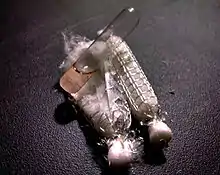Smelling salts

Smelling salts, also known as ammonia inhalants, spirit of hartshorn or sal volatile, are chemical compounds used as stimulants to restore consciousness after fainting.[1]
Usage
The usual active compound is ammonium carbonate—a colorless-to-white, crystalline solid ((NH4)2CO3).[1] Because most modern solutions are mixed with water, they should properly be called "aromatic spirits of ammonia".[1] Modern solutions may also contain other products to perfume or act in conjunction with the ammonia, such as lavender oil or eucalyptus oil.[2]
Historically, smelling salts have been used on people feeling faint,[3][4][5] or who have fainted. They are usually administered by others, but may be self-administered.
Smelling salts are often used on athletes (particularly boxers) who have been dazed or knocked unconscious to restore consciousness and mental alertness. Smelling salts are now banned in most boxing competitions.[1]
They are also used as a form of stimulant in athletic competitions (such as powerlifting, strong man and ice hockey) to "wake up" competitors to perform better.[1][6] In 2005, Michael Strahan estimated that 70–80% of National Football League players were using smelling salts as stimulants.[7]
History

Smelling salts have been used since Roman times and are mentioned in the writings of Pliny as Hammoniacus sal.[1] Evidence exists of use in the 13th century by alchemists as sal ammoniac.[1] In the 14th century's The Canterbury Tales, a character purports to use sal armonyak.[8] In the 17th century, the distillation of an ammonia solution from shavings of harts' (deer) horns and hooves led to the alternative name for smelling salts as spirit or salt of hartshorn.[1]
They were widely used in Victorian Britain to revive fainting women, and in some areas constables would carry a container of them for the purpose.[9] During this time, smelling salts were commonly dissolved with perfume in vinegar or alcohol and soaked onto a sponge, which was then carried on the person in a decorative container called a vinaigrette.[10][11] The sal volatile appears several times in Dickens' novel Nicholas Nickleby.
The use of smelling salts was widely recommended during the Second World War, with all workplaces advised by the British Red Cross and St. John Ambulance to keep smelling salts in their first aid boxes.[12]
Physiological action

Solid ammonium carbonate and ammonium bicarbonate salts partly dissociate to form NH
3, CO
2 and H
2O vapour as follow:
- (NH4)2CO3 → 2 NH3 + CO2 + H2O
- NH4HCO3 → NH3 + CO2 + H2O
The smelling salts release ammonia (NH
3) gas, which triggers an inhalation reflex. It causes the muscles that control breathing to work faster by irritating the mucous membranes of the nose and lungs.[6]
Fainting can be caused by excessive parasympathetic and vagal activity that slows the heart and decreases perfusion of the brain.[13] The sympathetic irritant effect is exploited to counteract these vagal parasympathetic effects and thereby reverse the faint.[14]
Risks
Ammonia gas is toxic in large concentrations for prolonged periods and can be fatal.[1][5] If a high concentration of ammonia is inhaled too close to the nostril, it might burn the nasal or oral mucosa. The suggested distance is 10–15 centimetres (4–6 in).[1]
The use of ammonia smelling salts to revive people injured during sport is not recommended because it may inhibit or delay a proper and thorough neurological assessment by a healthcare professional,[1] such as after concussions when hospitalization may be advisable, and some governing bodies recommend specifically against it.[15] The irritant nature of smelling salts means that if held too close to the nose, they can exacerbate any pre-existing cervical spine injury by causing reflex withdrawal away from them.[1]
References
- 1 2 3 4 5 6 7 8 9 10 11 12 McCrory, P (2006). "Smelling Salts". British Journal of Sports Medicine. 40 (8): 659–660. doi:10.1136/bjsm.2006.029710. PMC 2579444. PMID 16864561.
- ↑ "Mackenzies Smelling Salts". Electronic Medicines Compendium. March 2007. Retrieved 2009-01-03.
- ↑ Colburn, Dareth. "How not to faint at the altar". USA Bride. Retrieved 2016-06-17.
- ↑ "Smelling Salts". Compact Oxford English Dictionary. Oxford University Press.
- 1 2 Shakhashiri (2008-02-01). "Chemical of the week – Ammonia" (PDF). University of Wisconsin-Madison. Retrieved 2010-05-24.
- 1 2 "Henman's smelling salt solution". BBC News. 2002-07-02. Retrieved 2009-01-03.
- ↑ "Investigation: Ammonia sniffing popular in NFL". Florida Times-Union. February 3, 2005. Archived from the original on 2016-05-16. Retrieved 29 September 2016.
- ↑ Prewitt, Alex (March 17, 2016). "Smelling salts jolt of choice in NHL". Sports Illustrated. Retrieved 29 September 2016.
- ↑ "Antique gadgets". BBC News. Retrieved 2009-01-03.
- ↑ "Vinaigrettes by Sampson Mordan". Antiques in Oxford. Retrieved 2020-10-05.
- ↑ ""Bad Smells" and "Fragrance": Reading Mansfield Park through the Eighteenth-Century Nose". Jane Austen Society of North America.
- ↑ "Air Raids fact sheet: First aid kits". Caring on the home front. Archived from the original on 2008-11-20.
- ↑ "Fainting". WebMD.com. January 2, 2013. Retrieved April 22, 2014.
- ↑ "Why do smelling salts wake you up?". smellingsalts.org. 7 July 2015. Retrieved 7 July 2015.
- ↑ "Pitchside medical care". The Football Association. Archived from the original on 2007-10-29.